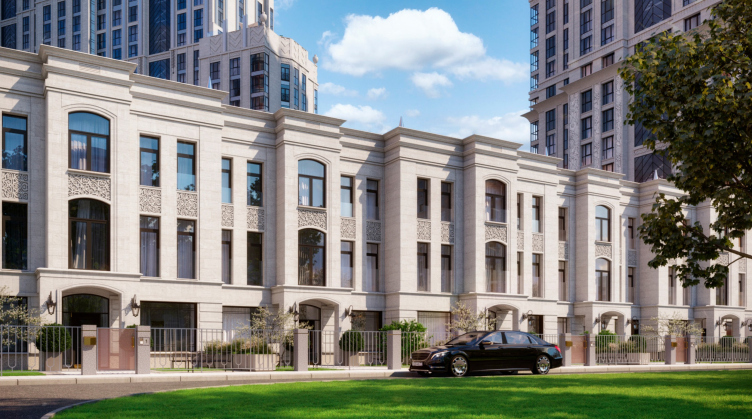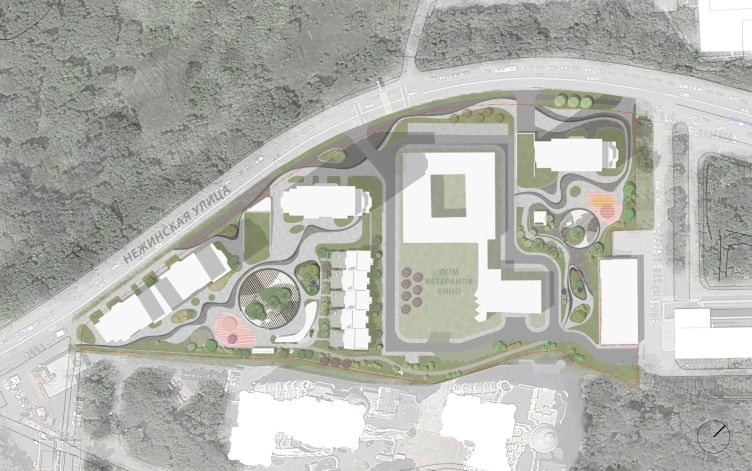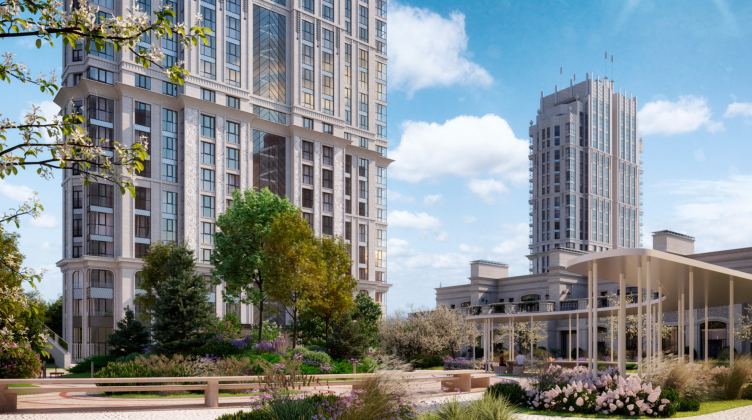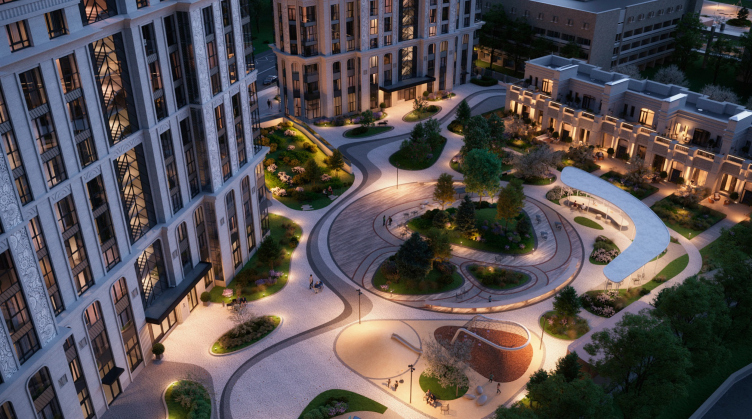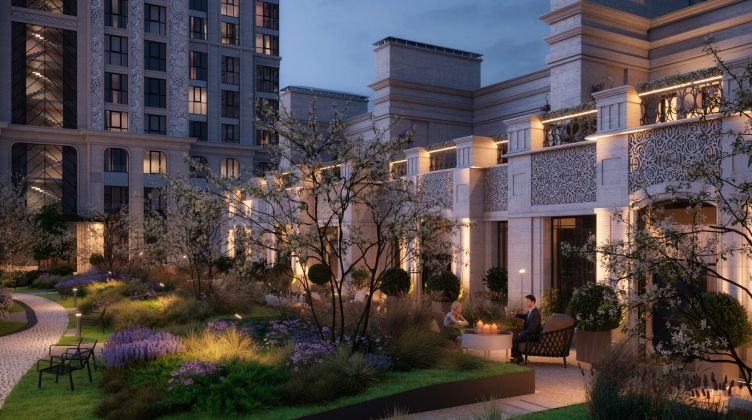Spires Residences
Copyright: © Tekta Group
The classic kind of land improvement could have turned Spires into the ultimate example of “heavy deluxe” – but, luckily, the client turned to GAFA, which was able to offset all the seriousness of the “premium-class” positioning with usual human joys, even though presented in an ostentatiously aesthetically highlighted form.
Spires Residences
Copyright: © Tekta Group
The Spires residences consist of three high-rise houses and five city villas. Curiously, almost in the very center of the complex, stands the “Dom Veteranov Kino” hotel – Jane Jacobs would have surely been pleased with such social differentiation within one city block. Also, the land site is adjoined by the “Volynsky” housing complex standing right next to it, but shutting itself off from the world by a rather high stylobate. Meanwhile, the Nezhinskaya Street separates Spires from the natural reserve “Valley of the Setun’ River”.
The master plan. Spires Residences
Copyright: © GAFA Architects
The proximity to the natural reserve both inspired the GAFA architects and allowed them to make the most out of the context, i.e. design not so much “wild” as urban nature, which has its own laws and purposes.
The first task that the architects needed to solve was the planning one. Two extensive, separated by Dom Veteranov Kino, are connected by two promenades: one is located on the side of the Nezhinskaya Street, turning it into an active city space with cafes and shops, while the other runs along the stylobate wall of the Volynsky housing complex and includes a few facilities of the special children’s route, more of which later. The urban villas and two-level apartments on the bottom floors have private little gardens of their own, which are delicately fenced off from the rest of the yard with strips of greenery.
Another challenge was the regulation driveways. The high-rise buildings of the complex are serviced by the city’s biggest fire truck, for the maneuvers of which about a third of the entire yard space had to be allocated. However, when you take a look at the layouts and 3D renders of the yard, emergency vehicles are the last thing that comes to mind – the driveways are masked by a smooth paving pattern, which looks more like a winding path, and by geo webs, in which the architects are planning to plant clover, known for its ability to mitigate the effect of prevalence of hard surfaces. In addition, the emergency drive runs through the central plaza, but, due to the masterful “drapery” of the pavement, you would never guess about it.
Spires Residences
Copyright: © Tekta Group
The coverages. Spires Residences
Copyright: © GAFA Architects
A plaza is quite an unconventional solution for a yard space. It serves to achieve one of the super-tasks that GAFA set for themselves – to help form the residents’ community by using architectural solutions. Towards this end, Spires gets yet another element – an exquisite pergola, custom designed specifically for this project. The pergola has two important features. First of all, it is aesthetically pleasing in itself and looks like an art object meant to give identity to this project, at the same time making the residents feel as if the are part of it, as well as to evoke the desire to take a photo – this quality of being photogenic has recently become more and more in demand. Second, and more importantly, the pergola is a place where neighbors can meet and communicate. The two main categories of residents who lack communication most of all are young moms and remote workers. For both of them, a large common table presents an opportunity to start a conversation. Furthermore, on the next level, you can get involved in many joint activities: picnics, table games, drawing or public readings.
The pergola means, of course, an opportunity to spend more time outdoors – with a laptop or with a view of the playground. This same purpose – to lure people outdoors and bring them back to an “analogue” feel – is served by other objects as well. For example, a sensory garden, where fragrant perennials are planted, blooming at different times of the year. Totally, it is expected that there will be as many as 100 types of plants planted on the territory of Spires, including grownup spruce trees, for which artificial hills are made.
Spires Residences
Copyright: © Tekta Group
GAFA also has a special approach to children – for them, they created a possibility of a spontaneous game without any “scenario” from the adults. The playgrounds form objects, which, due to their abstract design, can be interpreted in many ways, depending on where your imagination takes you, and this is why you never get tired of them: this is how a gadget-free person can come up with countless uses for a stick or a cardboard box. In addition, children’s objects are hidden throughout the entire yard space and become the reward for the curious: in the thicket, you can find a snag, stones, a labyrinth or even a musical instrument. The game elements are integrated into one common travel route that connects the two courtyards.
The project pays special attention to lighting, with which GAFA was assisted by ERCO and Vlad Obasov. According to the GAFA’s leading architect Victoria Barkalova, an average housing complex uses painfully little of all the possibilities that modern lighting technologies offer, and, when working on Spires, the company discovered a lot of new things: not all objects must be necessarily lit; tactical lighting leaves dark islets and creates accents – using it, you can highlight both architecture and landscape elements. Thanks to the lighting design, in the evening the complex looks strikingly different and creates a very special mood.
Spires Residences
Copyright: © Tekta Group
Spires Residences
Copyright: © Tekta Group
The yards, designed by GAFA, look like modern parks: they do not just have a lot of greenery and landscape objects in them, but also facilities for people aged from 0 to 80, while the space becomes recognizable and ties people strongly to their homes. In the case of Spires, the landscaping project adds value to the architecture, tying the buildings of the complex into a single whole and turning the space between them into a beautiful place to live in.



